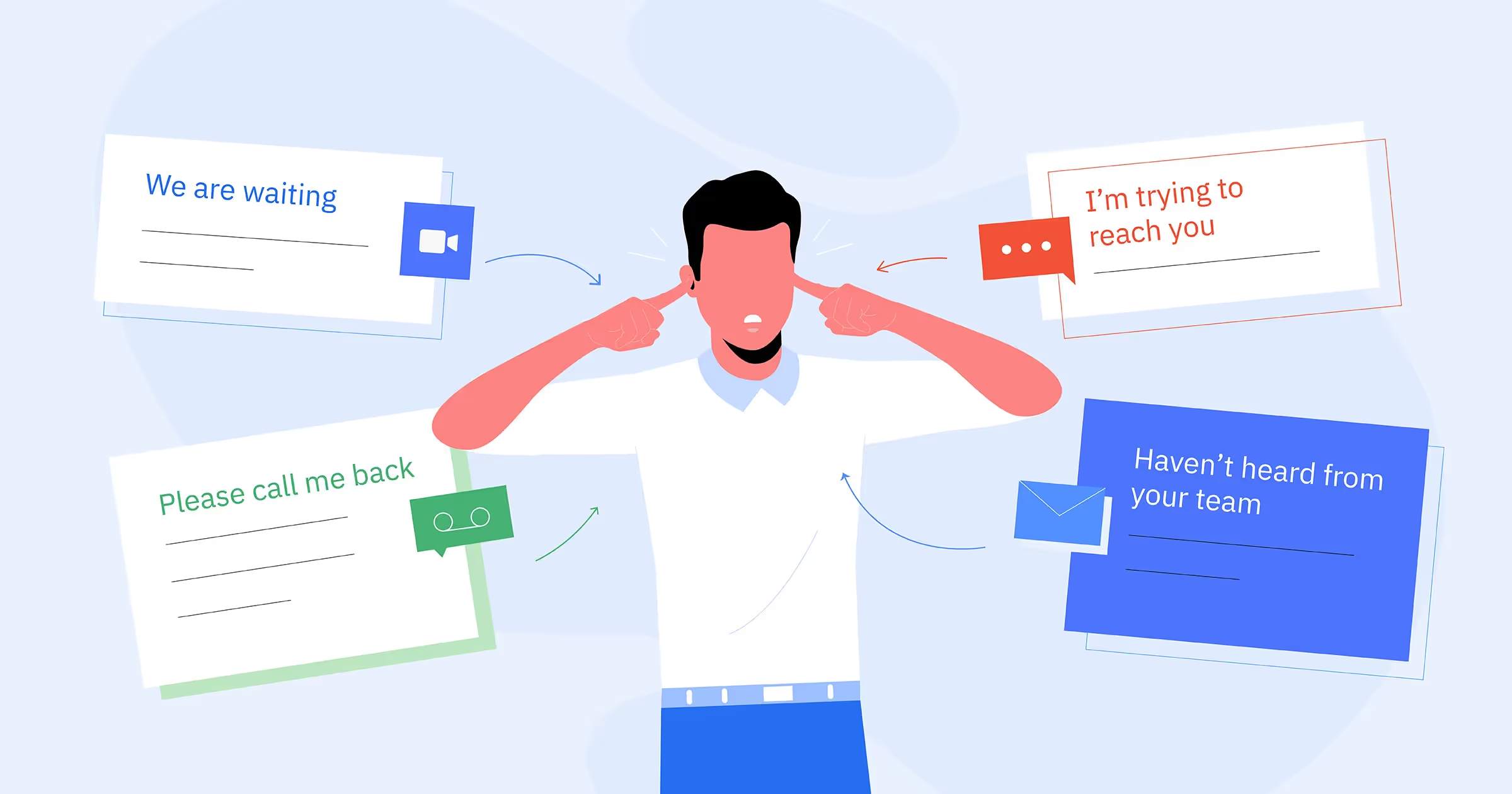You’re excited to finally onboard the new customer everyone’s been talking about. You’ve heard the sales team say that it’s been a tough lead to crack. But you couldn’t be more pumped about how exciting and impactful this could be. If all goes well, you’d have a great case study for the company, testimonials from your customer, and you could finally be off on that long-due vacation. All eyes are on you now to make sure the customer goes live within the next 90 days.
Three weeks go by.
You haven’t heard back from the customer after the project kickoff meeting. You’re waiting for their approvals on the requirements document and draft solution overview. Emails and calls to set up weekly meetings are going unanswered.
The writing is on the wall - you’re being ‘ghosted’. It’s unexpected, unsettling, and quite frankly, awkward.

You’re left wondering what to do - should you escalate to the project sponsor - or follow up again with the project team? Perhaps, giving things a breather might work. Or could that backfire?
In the rest of this article, we take the guessing out of the ghosting and look at understanding what might have gone wrong, how you can fix it, and ways to avoid being ghosted in the first place.
Read on to know:
- Why customers ghost you
- How to avoid getting ghosted
Why do customers ghost you?
How did things get here, and so soon?
Your mind is buzzing.
Maybe it was something you said. Or didn’t say. Or did. Or didn’t do. Did the kickoff meeting say too much and overwhelm them? Or say too little and leave them unimpressed?
While it’s natural to take things personally, it’s important to objectively understand what led to this. Here are the top six reasons customers ghost vendors even after signing a contract:
1. Change in organizational priorities/responsibilities
A classic case of it’s not you, it’s them. It’s likely that something more important came up that put your project on the back-burner. Or, the customer champion or Project Lead is in the middle of a responsibility/authority transition that they might not be comfortable revealing to you just yet. So instead, they ghost you.
2. Customers no longer see value
While the sales team may have a fantastic and perfectly- pitched sales pitch, your onboarding didn’t quite hit the right note on value delivery. Simply put, your customers don’t see the value you deliver and this leads to a lack of buy-in from key members involved in the actual implementation.
This could also happen if key members were not involved in the initial phases of the sale or in your kickoff meeting.
3. The timing is off
This is more common than you’d think. Your client’s project team is unresponsive simply because they have their hands full. Maybe, organizationally it’s a busy time for them, a bad time for business, or even the annual slump or down-time.
4. Unrealistic planning and timelines
It’s likely that your key liaison is not engaging because the project team doesn’t find your project plan and timelines to be realistic. This could cause them to severely doubt your understanding of the project and your competence to follow through.
On one hand, they could be overwhelmed by what lies ahead for them. On the other, they could take things easy, convinced that the project would be delayed in any case - given the impractical timelines.
5. Difference in working styles
In addition to the timelines, a fundamental lack of alignment - in the division of responsibilities, pace of engagement, or working styles is a huge deal-breaker. They could have found your approach slow and lacking, or too fast-paced and aggressive, or just impractical and lacking in actual experience.
If you look closely, most of the above issues boil down to three things - communication, understanding, and trust. If the transition from sales to onboarding falls short on any of these, your customers are more likely to ghost you.
In the next section, let’s look at what you can do to get your project back on track.
How do you avoid getting ghosted?
While there’s no way to 100% ghost-proof your business, there are ways to proactively avoid setting yourself up to be ghosted. Here are seven key steps to take:
1. Get all the key members for your kickoff meeting
Your kickoff meeting is your first and best shot at building trust, alignment, and making your customers realize the lasting value in your offerings. Make sure your kickoff team has all key stakeholders - decision makers, champions, executive sponsors, and the project team that will be working with you.
Go ahead with a kickoff call only when you have 100% participation from key parties. Before the meeting, make sure to share an agenda, outline the role each of them needs to play in the meeting, and treat them as equal partners in the process.
2. Set up steering committees
Ensure that you set up steering committee meetings and secure time from key decision-makers and sponsors at the management/leadership levels. Seeing their leaders commit to their times in advance pushes the project team to align to deliver. These steering committee meetings act as a forcing function towards accomplishing project goals on time.
3. Establish the 'Rules of Engagement'
Make "how we work" a core part of your stated agenda in the kickoff meeting. Use this time to showcase your approach to working together. Ensure that the customer is comfortable with your process, communication channels, and protocols - for follow-ups, reporting, and even escalations.
If the customer suggests a different approach, make sure you discuss it in detail and document and share it for future reference and decision-making.
4. Showcase your methodology
Show the blueprint of the journey from here while committing to a go-live date. Make sure to include realistic timelines from your end. It increases their belief in the go-live and helps them commit to it rather than assuming things will be delayed anyway.
To make sure the customer is not overwhelmed by the efforts needed from them, showcase how your project management style and tool is designed to help. Understand points in the journey where they would need more support and assure them that you will hold the fort at those stages.
Pro tip: Make sure you create checkpoints at each key milestone to get feedback from your customers. Make sure to highlight these as part of your project plan.
5. Communicate resource and time commitments
Illustrate with concrete instances, at what stage stakeholders need to be involved, and to what extent - for example, who needs to be available for a 2-hour review in week 1; who approves a milestone in week 2; which project team members need to deliver something in week 4, et. This way, not only are you holding them accountable, but also presenting a well-prepared approach at your end.
6. Discuss risks and potential conflicts upfront
Have an open discussion with the project sponsor or champion to understand where the priority of your project lies in their larger scheme of things. At this stage, it’s helpful to understand the strategic goals of the company and align or modify your project, if possible, so as to move it higher on the priority scale.
Understand what could derail this project and if they see any other initiatives potentially taking center stage during the implementation and deployment phase. This is a good time to discuss how you should handle your efforts and time investments in such cases. This increases your awareness, gets them to commit, and creates an environment for easy and transparent communication.
7. Focus on value at each stage of engagement
While your sales team would have focused on value delivery in their initial conversations, it is up to you to help the actual project team see value - at each stage and for each implementation piece.
Right at the start, work out the ROI for the customer upfront, even if it’s only rough math, as part of the kickoff - for the whole project team to understand. This way, the customer is signing up with a clear ROI goal and therefore, less likely to flake on you.
Share the value already being delivered from each phase of the implementation. Even better, get the customer to confirm these at each point. Get the project sponsor and business owners to agree on priorities of the various pieces of the implementation, and articulate the value of each for their team and organization.
Understanding and optimizing for Time-To-Value (TTV) will also help you pick the right scope and size for each phase of implementation. For more on value realization, read this article on the basics of value realization.
The kickoff meeting: Your project ghostbuster
As you would have noticed, the best ways to avoid getting ghosted are to make a great first impression, communicate honestly, and show long-term alignment. Your kickoff meeting helps you do just that. Without an effective one, you could be setting yourself up for a slow start - at best, and at worst, a botched project.
We cannot overstate the value of getting your kickoff meeting right - it sets the tone for the engagement, aligns both sides, and creates the right transparency and comfort with each others' work styles. This comprehensive article on running successful kickoff meetings can help you nail your kickoffs.
In conclusion...
Given the nature of business today, ghosting is a part of the game, and in some cases - out of your control. But, communicating effectively and honestly, building trust, and delivering value are. And so is getting out there and trying again another day.
Now that we have seen why customers ghost us and how we can avoid it, let's look at what we can do to revive a project that has been stalled thanks to their ghosting.















